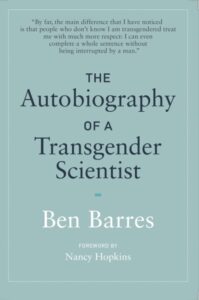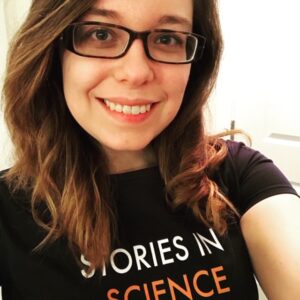 Who are the scientists behind the research? What are their lives like? What are the stories of their discoveries, failures, and successes? To celebrate Pride Month, June’s book club read is Autobiography of a Transgender Scientist by Ben Barres. As a neuroscience masters student, I often read scientific articles on brain development written by Ben Barres and his lab. But it wasn’t until 2017, two years into my program, that I heard of his passing and started to read articles about his fascinating life. His autobiography was at the top of my list when deciding which book would kick off our Down to a Science Book Club series.
Who are the scientists behind the research? What are their lives like? What are the stories of their discoveries, failures, and successes? To celebrate Pride Month, June’s book club read is Autobiography of a Transgender Scientist by Ben Barres. As a neuroscience masters student, I often read scientific articles on brain development written by Ben Barres and his lab. But it wasn’t until 2017, two years into my program, that I heard of his passing and started to read articles about his fascinating life. His autobiography was at the top of my list when deciding which book would kick off our Down to a Science Book Club series.
Ben Barres was born Barbara Barres in 1954 and was raised in West Orange, New Jersey. As a child, Barres’s family went to the local public library once a week, where science became an early interest. Barres recalls a hunger for science and a childish frustration that their mother would only let each child take out two books at a time. At the age of four or five years old, Barres decided to pursue a career as a scientist, which lead to a lifelong passion and curiosity for science.
As Barres’s interest in science began to develop, so also developed an awareness at the age of 3 or 4 that she was a boy. Barres remembers feeling different in interests, clothes, and behavior, and discomfort in growing into a body that did not feel like it fit. It wasn’t until college that Barres realized that she had Mullerian agenesis, a condition where some people are born without female reproductive organs. Barres struggled intensely with strong feelings of gender dysphoria and confusion, felt embarrassed and ashamed, and was completely unable to tell anyone: “…growing up I was too confused to talk with anyone about it or to have any idea what to say. It just made no sense that I was a girl feeling like a boy. How could I even utter something like that to anybody?” It wouldn’t be until the age of 40 that Barres would understand what it meant to be transgender or be able to do anything about it.
In the face of this confusion, Barres delved into science by enrolling in local science programs and attaining a summer job at Bell Labs as a teenager, with an initial interest in coding and computer science. Starting an undergraduate career at MIT was the first time that Barres felt a sense of belonging and saw other people who had a similar passion for science. However, Barres also saw conflicting messages about being a woman in science: “When I arrived in the fall of 1972, I found that only 5% of students at MIT were women. As I felt that I was a boy, however, I did not particularly notice this and it did not concern me.”
However, as Barres’s studies progressed, the ingrained injustices against women became clearer: “In 1972-1976, the years I attended MIT, there were almost no women on the faculty, so women students did not see many role models.” In one particularly vivid experience, Barres recalls being the only person to be able to solve a difficult question on a take-home final exam of an artificial intelligence course. However, the professor didn’t believe that Barres had done the work and said that a boyfriend must have done it: “I was offended because he was unfairly and wrongly accusing me of cheating. It was many years before I realized that his meaning was deeply sexist—he just couldn’t believe a woman had solved the problem when so many men had been unable to.”
Barres attended Dartmouth Medical School, specializing in neurology, from 1976-1979, and then completed a PhD in Neuroscience at Harvard Medical School in the 1980s. Though graduate school was full of rigorous struggles, it also provided the freedom to research new topics and learn new techniques. Barres completed a postdoctoral fellowship under the mentorship of Linda Chun, David Corey, and Martin Raff. In his book, he reflects on the significance of this high-quality mentoring in the development of his professional self.
In 1993, Barres accepted an assistant professorship at Stanford, started a new lab studying central nervous system (CNS) neurons and their interactions with other brain cells, and developed techniques to purify and isolate neurons in order to study their function. Barres spends a significant amount of time in his book explaining his life’s work, which includes researching oligodendrocyte development and myelination; methods to purify astrocytes; astrocyte transcriptome; the role of astrocytes in synapse formation and function; human astrocytes; new tools to study microglia; the blood brain barrier; reactive astrocytes and their role in neurodegenerative diseases; and founding a biotech company.
At the age of 40, Barres developed breast cancer and made the decision to have a mastectomy. He recounts the experience of talking with a doctor about this preventative treatment to remove healthy breast tissue: “I also told him that I did not feel like I should have breasts, mentioning this to someone for the first time in my life.”
After 4 years at Stanford, Barres received tenure. At this time of professional and financial security, Barres still struggled with the gender confusion that had always loomed. One morning, while reading the local newspaper, Barres came across an article about Jamison Green, a female to male transgender person and trasngender rights activitst, whose experiences with gender disphoria were very similar: “This was the first time that I understood that there were others who had the same gender identity discordance that I had. It was also the first time that I had heard the word transgender…I felt an irresistible desire to transition from female to male from the moment I was offered that possibility.”
The only thing that held Barres back was concern over career impact. Would transitioning affect funding, feelings of incoming students, perceptions from colleagues, or invitations to meetings? Barres decided to open up to three trusted colleagues and ask for advice. All three were unanimously supportive of transition, and in December of 1997, Barres sent out an email to everyone in his acquaintance telling them of the decision, changing his name to Ben, and asking others to use his/him pronouns.
Fortunately, Barres received many supportive responses to his decision: “I am not aware of a single adverse thing that has happened to me in the past twenty years as a result of my being transgender, but there was the immediate relief of all emotional pain as a result of my transition. It is hard to explain how much relief I felt and how much happier I became. It was as if a huge weight had suddenly been lifted from my shoulders.”
Barres was the first transgender person to be elected to the National Academy of Sciences (NAS) in 2013, and he became a strong advocate for transgender people and children. In a 2006 Nature article, he fiercely combats the then-topical assertion that innate gender differences were to blame for why so few women succeeded in STEM (science, technology, engineering, and math): “Growing up transgender in a time of universal ignorance and hate has been difficult and emotionaly painful. I believe that most or all of this pain is preventable in a future world where people are less ignorant, more supportive, and more understanding. I have tried my best to help others by being open about my transgender identity and by being as good a scientist, mentor and human being as I have been able to be.”
True to this statement, at the end of this book Barres lists all of his trainees and the positions they achieved by 2017. In 2013, he wrote an article in the journal Neuron called How to Pick a Graduate Advisor, which delves into the importance of mentorship for students’ professional and personal growth. It is clear from his writings that his relationships with his trainees were one of the greatest joys of his life.
Before reading this book, I had already admired Ben Barres’ scientific advances in the field of neuroscience. But as I started reading, I felt like I was listening to a brilliant mentor and friend. As he talked about his struggles with gender identity and mental health, and his passion for advocacy, I felt like I knew the man behind the research. In The Autobiography of a Transgender Scientist, Ben Barres’s legacy and mentorship lives on for future generations to read.

Amanda Coletti is a Communications Research Assistant at the Connecticut Science Center and a Ph.D. student in the Department of Communication at the University of Connecticut, where she studies the science behind science communication.



